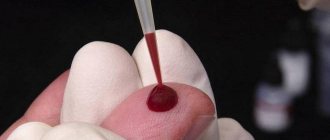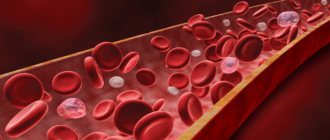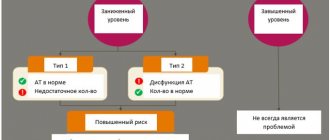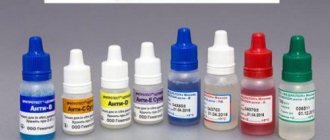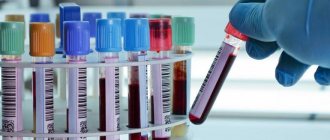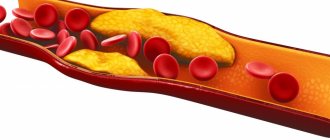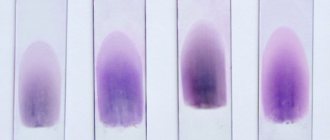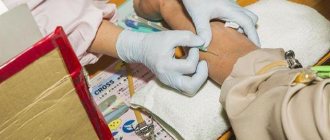Testing blood for clotting is a common test, the decoding of which gives the doctor a lot of information about the patient’s well-being. The Lee-White clotting time test has become popular due to its simplicity and effectiveness. For example, if clotting is higher than normal, the person has problems with the thyroid gland, or has recently suffered blood loss. If the blood clots slowly, serious problems with internal organs are possible, or a severe infection is present.
Blood
Meaning and purpose of analysis
Coagulation time testing is a general coagulation test that can be used to identify a variety of dysfunctions in the functioning of body systems. A comprehensive analysis of indicators is called a coagulogram. This blood test helps evaluate the condition and functioning of various components of the blood systems.
The blood released from the vessel, after some time, changes from liquid to a jelly-like state. The speed of this process depends on: several factors, the number of blood cells - platelets and plasma proteins, and the condition of the blood vessels. All this is of great importance; their correct ratio is one of the main parameters of a healthy person’s body.
Preparation and procedure
To obtain the most accurate results for analysis, you need to prepare in advance. You cannot eat before taking the test. The break between donating blood and the last meal should be 12 hours (2-4 hours is allowed for small children). It's better to have a light dinner not late in the evening. Dense, canned, fatty foods with seasonings provoke incorrect readings. Pure water (not mineral) is allowed; it is advisable to exclude any other drinks - juices, coffee, alcohol.
An hour before the analysis itself, you should not smoke, it is not recommended to worry, or do physical effort (walk quickly, run). It is necessary to exclude the use of drugs that change coagulation parameters - medications, vitamins, dietary supplements. If the patient is undergoing or has recently undergone treatment with anticoagulants, it is necessary to inform the specialist about this.
A little blood is taken from a vein, 1 - 3 ml, usually the cubital vein is used. The biomaterial is taken without applying a tourniquet. Sometimes one tube is filled, sometimes two or three, it depends on the method by which the test will be done.
Importance of analysis to determine the level of coagulation
A clotting test is used to identify diseases accompanied by bleeding or, conversely, possible formation of blood clots. A similar test is done before various surgical interventions, operations or diagnostics, if the patient is prescribed medications that affect coagulation. The blood coagulation system consists of many elements, therefore, to determine its parameters in full, a detailed coagulogram is used.
It is very important not to miss any serious deviations from the required values; even minor disturbances in the coagulation system (hemostasis) can indicate serious and dangerous diseases. The method clearly demonstrates the presence or absence of pathologies, which is why doctors often resort to prescribing this particular technique. Based on the research data, you can roughly understand what disease a given person has developed and prescribe additional tests. After diagnosis, treatment should be started without delay, since diseases in which coagulation changes have a serious impact on human health.
It is important to know! A blood test using the Lee and White method is an effective way to determine the normal rate of clotting; thanks to it, doctors can promptly diagnose developing pathologies and prevent the development of dangerous diseases that threaten human life.
Blood composition
Treatment of SVC syndrome
The need to treat the SVC phenomenon is determined by a cardiologist-arrhythmologist based on the results of the examination and risk assessment.
For WPW syndrome, despite the fact that various drug treatment regimens for UPW syndrome have been developed, cardiac surgery is a radical treatment method. Radiofrequency ablation is considered the modern method of choice in the world, which is also performed in the arrhythmology department of our hospital.
The latest technologies and equipment - the use of the non-fluoroscopic mapping system "CARTO" - make it possible to conduct an intracardiac electrophysiological study directly during a minimally invasive operation with access through a vessel, which helps to accurately determine the location of the pathological impulse and then coagulate it, restoring normal sinus rhythm. The department is headed and almost all operations are performed by one of the leading operating arrhythmologists in Russia, Doctor of Medical Sciences, Professor A.V. Ardashev.
Thanks to the use of this method in foreign cardiac surgery practice, 100% of identified cases of SVC syndrome are approaching cure.
Who is recommended to undergo testing?
As mentioned above, an analysis is required in preparation for any surgical intervention, even if there are no symptoms. It is mandatory to undergo the test throughout pregnancy; this is important and can save the life of the child and the mother. Based on the coagulogram readings, the doctor can judge the risk to the patient’s life during surgery or the birth process.
There are many pathologies that can affect the hemostasis process. These may be: disturbances in the functioning of the hematopoietic organs - liver, bone marrow; associated with a deficiency of nutrients (vitamins). Taking many medications can affect test results (antibiotics, aspirin, cytostatics), problems with the immune system, various inflammations and other reasons can reduce or increase the rate of clotting. In the first case, large blood loss is possible when the bleeding cannot be stopped; in the second, it threatens the formation of blood clots, stroke, or heart attack.
Interesting fact! There are hereditary causes, for example the disease hemophilia - the inability of blood to clot. A person can simply bleed to death at any moment. Only men suffer from this disease, never women.
Also indications for the purpose of the analysis:
- inability to carry a pregnancy to term, frequent miscarriages;
- diseases of blood vessels, heart, pathologies of the circulatory system, arrhythmia, heart attack, ischemia, stroke, varicose veins, thrombosis;
- severe injuries, injuries with internal or external bleeding;
- dysfunction of the liver, kidneys;
- anemia, heavy blood loss during menstruation, frequent nosebleeds,
- the analysis is carried out during a routine medical examination or when a person is admitted to a hospital;
- treatment with anticoagulant drugs;
- long-term therapy with glucocorticosteroids;
- taking oral contraceptives;
- long-term use of anabolic steroids.
Indicators of a blood test for coagulation should be carefully studied by the attending physician to make a correct diagnosis, clarify the risk and likelihood of thrombosis (bleeding).
Basic criteria for blood clotting
The duration of the bleeding process is directly affected by blood clotting. Thanks to this process, blood loss during wounds is prevented. Blood clotting is part of the work of hemostasis. Coagulation consists of primary hemostasis, hemocoagulation, coagulation, plasma hemostasis, secondary hemostasis.
Thanks to this process, the formation of strands of blood protein called fibrin is observed in the blood. It forms blood clots, which eliminates the possibility of blood flow and stops bleeding. Bleeding disorders are affected by a variety of causes. In order to avoid undesirable consequences, you need to know the normal blood clotting time and compare it with your indicators.
In order to find out as accurately as possible the duration of bleeding in your body, you need to take a blood test called a coagulogram and hemostasiogram.
Thanks to the results of this comprehensive analysis, the presence of certain diseases in the patient is determined. Initially, a normal bleeding time is required, which ranges from 1 to 3 minutes. It takes 10 minutes for the bleeding process to complete.
You can find out the duration of bleeding as accurately as possible using a special analysis. For this purpose, you must contact a medical center.
Indicators
Interpretation of a blood test for coagulation
Bleeding and the speed at which it stops directly depends on certain indicators.
The rate of blood clotting directly depends on:
- Thrombosed time
- Bleeding time
- Clotting time
- Antithrombin 3
- Fibrinogen
The main indicator of the characteristics of the blood clotting process is thrombin time. Normally it should last from 14 to 21 seconds. This indicator directly depends on what methods of determining it are used. Antithrombin 3 is an indicator that affects the formation of the smallest number of blood clots. This is a regulator of the coagulation circulatory system.
- Blood coagulogram (blood clotting test): interpretation in adults, norm in the table
The fibrinogen level should be from 2 to 4 g/l.
Thanks to this criterion, it is possible to characterize the functions of the blood coagulation system and determine the possibility of inflammatory processes in the body. It may be influenced by several medical factors.
Bleeding in an adult should last between 2 and 4 minutes. The level of blood clotting directly depends on its characteristics. A blood clot should form within 2-5 minutes. The faster it is formed, the sooner the bleeding will stop.
Blood clotting and the role of the process in the life of the body
Inside any multicellular organism there is its own liquid environment, consisting of blood plasma, tissue fluid, and lymph. It is very different from the external environment, so there is a vital need to preserve it when the integrity of the body is violated. This ability arose in humans and higher vertebrates in the process of evolution - such a protective reaction of the body is called the blood coagulation system.
Any damage to a blood vessel causes special protective mechanisms to turn on. Platelets immediately change shape, turning into something similar to balls with processes. With these outgrowths, platelets adhere to each other, forming a tightly woven mesh. This formation “clogs” the rupture site, forming a protective thrombus, a “plug.” The thrombus prevents blood from flowing out of the vessels and pathogenic microorganisms from the outside entering the wound. The creation of such a natural obstacle is the main function of the blood clotting process. The medical term hemostasis includes all stages from tissue damage to the dissolution of a no longer unnecessary “plug”.
Clotting
Description of the method
How is clotting time determined according to the Lee-White method? The rate of blood clot formation is carried out at an optimal temperature of 37 °C. 1-2 ml of venous blood is collected into a clean, dry test tube (glass, silicone). As soon as blood appears in the needle, the laboratory assistant starts the stopwatch. Next, the test tube is placed in a special stand, tilted at an angle of 50 degrees. Every half a minute the test tube is shaken to determine whether the sample has coagulated. Liquid blood flows onto the walls of the test tube, but thick blood does not. As soon as thickening appears, the stopwatch is turned off and the time of the appearance of the clot is noted.
If the room temperature is 18-22 °C, the thickening rate is 5-10 minutes, at 37 °C - 5-7 minutes. The test rate may depend, in addition to temperature, on the type of tubes used. When using standard glass - 4-7 minutes, silicone - the clot formation time increases - 15 - 25 minutes inclusive. There are several modifications and options for performing the Lee-White test. The classic version uses a three-tube test. It is possible to use double-tube and single-tube options. Some authors insist on “classical” methods.
Timing
Interpretation of the analysis
The time interval from the appearance of venous material on the walls of container No. 1 (the moment the stopwatch starts) until the formation of a clot inside container No. 2 means the total time of coagulation of the material in contact with the glass.
In container No. 2, a blood clot occurs later than in the first container. This happens because before the clot appears, the first container is motionless, and the material is not affected by mechanical vibration to the sides.
By adding the clotting time of the material in the first test tube to the delay time of clot formation in the second container, the laboratory assistant calculates the time correction for mixing by fluctuations.
Normal clotting values
For complete accuracy, from this result it is possible to calculate the time difference in the flow of blood parts into both tubes, but this correction does not affect the result of the analysis.
Example:
- the time of arrival of material particles in container No. 1 (start of the stopwatch) is 0 sec, in container No. 2 – 22 sec;
- clot formation time, coagulability: initial tube – 5 min 30 sec; next test tube – 8 min 50 sec,
- the coagulation period in both tubes is 8 minutes 50 seconds, and with reference to the later withdrawal into the second container: 8 minutes 50 seconds, subtract 22 seconds, you get a period of 8 minutes 28 seconds.
The usual, without deviations, period of clot formation and coagulation of test tube 1 is 5-10 minutes; dishes No. 2 – 7 – 11 min. The total cumulative period is 7-11 minutes. In medical practice, determining blood clotting time according to Lee White is the simplest test; it indicates global disturbances in the functioning of the circulatory system.
How the research is carried out
The test technique is simple, but gives a complete picture of the state of the coagulation system. Take a dried test tube with a volume of 1 ml. When drawing blood, it is important to ensure that no oxygen bubbles enter the needle. The needle should be inserted as quickly as possible so that tissue particles do not enter the bloodstream. Be sure to spray the first 1-3 drops onto a cotton swab.
The important thing is that the blood mass begins to thicken as soon as the needle is removed, so you need to keep a stopwatch handy in advance. When collecting material into a container, it is important to start the stopwatch as soon as blood reaches the surface of the wall. When collecting test material, insert the next test tube, using a stopwatch to record the moment the blood hits the glass walls of the container.
According to Lee-White
Other Analysis Options
The Lee White blood clotting test has three methods:
- The analysis can be carried out at temperatures from + 18 to + 23°, but this reduces the accuracy of the result. The usual period of thickening of the test material in the first test tube is 5-10 minutes; The period of concentration of the contents of two test tubes is 12-16 minutes.
- There are also single-tube tests or simultaneously in two containers with simultaneous oscillation in order to determine the average time period for thickening of the test material. Such methods are not variations of the Lee White test for the simple reason that they do not have a time correction for 65-75° fluctuations. And yet, in case of deviations from the norm of hemostasis, they can be used to quickly obtain results.
- There are also micro-methods in which the result is not as accurate as in the Lee White method. Using them, you can get a picture of the state of the blood even with a small volume for analysis - 0.1 and 0.2 ml. Such micromethods are convenient in pediatric practice, when the child is unable to obtain the required amount of blood from a vein.
First way
To determine the clotting time of test blood at 37 °C, a small volume of blood is required and no correction is made for turbulent mixing. Using a sterile needle without a syringe, material is taken for analysis on the inner elbow bend into two glass tubes of 0.1 ml each. The first 2-3 drops are applied to a cotton swab.
The stopwatch starts when the test material hits the glass of the test tube. Then the containers with blood are placed in a water bath at 37 ° C after 2 minutes and tilted 50 ° every half a minute. When a clot forms and spreading stops, the time on the stopwatch stops. The clotting period is indicated in minutes as the average of two containers.
Perception of the result
In this micromethod, the coagulation rate is 5-10 minutes. Deviations towards increasing time are interpreted as hypocoagulation; a period shorter than 5-10 minutes indicates hypercoagulation.
Second way
The test technique is exactly the same as in the first method, only 1.0 ml of material is collected from a vein on the inner bend of the elbow.
Reasons for changes in clotting time
Blood clotting times may differ from normal.
Increased speed
Excessively rapid blood clotting indicates a threat of vascular blood clots and disruption of the functions of life-supporting organs. Thrombosis is a very dangerous disease, often leading to death. If blood clots appear too quickly, the risk of blood clots and complications such as heart attacks and strokes increases. Increased coagulability, that is, shortened clotting time of venous blood according to Lee White, occurs in the following diseases:
- hypertension;
- problems with blood vessels in diabetes mellitus, atherosclerosis;
- increased destruction of red blood cells (hemolytic anemia);
- autoimmune diseases (rheumatoid arthritis);
- various injuries, shock, burns (initial stage);
- sepsis or blood poisoning;
- stress hormones, increased adrenal gland function;
- disruptions in the functioning of the kidneys or pancreas;
- dehydration due to severe vomiting or diarrhea;
- high temperature for a long time;
- taking hormonal medications;
- some diseases tuberculosis and pneumonia;
- oncology;
- anaphylactic shock, severe allergies;
- cretinism disease;
- state of pregnancy.
Pregnancy
Reduced speed
Low coagulability, that is, slow coagulation provokes bleeding and poses a threat in case of injury, childbirth and many other situations related to the violation of the integrity of the skin. The cause may be congenital pathologies (hemophilia, deficiency of coagulation factors), and it can also be provoked by:
- long-term treatment with medications - anticoagulants, antibiotics, antiplatelet agents, aspirin, antitumor drugs;
- lack of fresh greens in the diet, which leads to vitamin K deficiency;
- exhaustion of the body;
- viral and microbial infections;
- neoplasms, especially blood and bone marrow;
- liver diseases, cirrhosis;
- second stage of DIC syndrome;
- irradiation;
- alcoholism;
- hemorrhagic diathesis in infants;
- overdose of heparin and other blood thinners
- lack of fibrinogen, thrombin, as well as a decrease in their activity;
- severe toxicosis in pregnant women;
- congenital fibrinogen deficiency;
- chronic kidney disease;
- burns;
- pathologies of the thyroid gland;
- poisoning with substances that cause asphyxia (phosgene, mustard gas);
- heavy bleeding or frequent blood transfusions.
Bleeding
Platelets protect us from any blood loss in dangerous situations. Based on a blood clotting rate test, you can understand how the body works as a whole and whether there are any malfunctions in its functioning. But do not panic if you see a low level of platelets or deviations from normal coagulation in the test results; only a doctor can find out the real reason for such changes based on a full examination and additional research.


